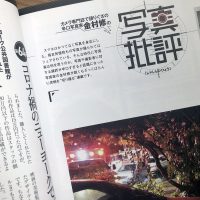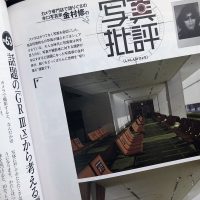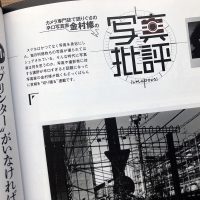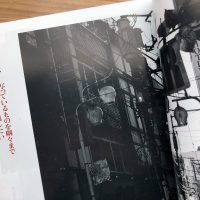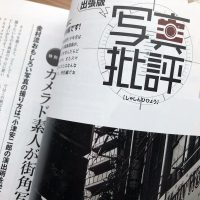
Video installation ”Shrimp Cocktail President” by Osamu Kanemura
MAY 12 – JUN 2, 2018
At The White, Tokyo
Osamu Kanemura’s newest movie work is shown. The movie work is reflected using projectors on every walls of the gallery.
神保町のALTERNATIVE SPACE 「The White」で、金村修の新作映像展が開催されます。
未発表映像作品、“Shrimp Cocktail President”を四方の壁面にプロジェクション。本展は、映像でギャラリー空間を満たすヴィデオインスタレーション展となります。
Statement
I remember watching Shinji Somai’s “PP Rider” and being surprised at the amount of people using a stopwatch to time the movie’s longest scene that clocked in at about ten minutes. Shinji Somai is well known for his long takes, and whenever he released a new movie people were always timing it to see just how long the scenes would be. However, I felt that time was not the problem. It amazed me that I could feel “PP Rider’s” endless time and for this endless time to be measured at 10 minutes. The time delaying effect of that shot and the actual time of the shot measured by a stopwatch made for two different times that were incompatible with each other. I was surprised that my feeling of endless time had a numerical value. I felt that were two times, quantifiable time and another type.
The passage time measured by a stopwatch, something that the people watching the movie could agree upon versus the passage of time that I felt watching “PP Rider,” something that no one else could relate to, did not relate with each other. This element of comprehension was intriguing; Shinji Somai’s purposely placed long takes broke down the linear passage of time. Somai’s films took linear time and warped it.
Did the contortion of time also warp the movie’s described space? Multiply speed by time you can find distance, but if the time becomes warped will distance also contort as well? The formation of distance gives rise to space, but if time becomes warped will the contortion of time cause space to dislocate? Someone said that time is the corrupted figure of space, and if that is true, Somai’s long cuts took the feeling of endless time and enlarged the space in the film. By employing these long cuts was his aim to change space by changing time? Time, as a numerical value or measured, was rendered meaningless and become something else entirely due to these long cuts. These two segmented times are presented by normal space and distance along with warped space. The film takes the reality of three dimensions and cuts through them.
If you proceed in a straight line, having a lot of shots will imply a closeness of time. Lining up all the points with the ones proceeding in a straight fashion allows for a constantly renewing movement to your film. However, time feels like it is engulfed in a whirlpool, much like Howard Hanks’ films where time was sped up faster than normal, or like Alexander Sokurov’s films where it came to a standstill. Time is always perturbed. Perturbed time is a part of the film, as well as uniformly proceeding time, and this is what gives way to the contortion.
“Shrimp Cocktail President” is not a lovely, well-stirred cocktail, nor is it like a shrimp cocktail served at parties for the visual attraction. Death can be achieved in a moment, but its continuation or removal is impossible, and I think films are events of the moment. You can replay a certain moment in a film over and over, but why is it that when you replay that moment your eyes look at a different direction than before?
Due to the image lacking permeant identity is perhaps why I cannot see the same place twice. The moment captured in the film is vague, lacking a firm existence; its interpretation changes with who is watching, a myriad, fictional past that lacks existence. The film with its accumulation of uncertain moments change upon multiple viewings. That is where time’s heavy existence ceases to exist. Gathering a lot of shots does not insure that we can share a universal past.
“Shrimp Cocktail President” is the moment’s existence, the time referred to as the past and how its relevance is missing. Like the weightlessness of “PP Rider.” Time’s abandonment of time. Sustaining or removing time is impossible, but via films you can re-watch endlessly the moment of death. Like a memory that is updated every time it is played, its universal form lacks existence except for a flat image. Replaying does not integrate fragmentated time into our memories, rather I think that replaying further fragments and obliviates.
Written by Osamu Kanemura
Translated by Marty Mora
ステートメント
相米慎二の「ションベンライダー」を観たとき、トップシーンの長廻しが10分近くあるとストップウォッチを片手に騒いでいる観客がたくさんいたのを覚えている。相米慎二は長廻しで有名な監督で、新作が発表されるたびにワンショットの長さが今度はどのくらいの長さなのかといつも話題になっていた。けれどそれは時間が問題だったのではないような気がする。「ションベンライダー」のいつ終わるのだろうというような無限の時間の長さを感じさせる長廻しが、ストップウォッチで測るとそれは10分という数学的な時間に測定されることへの驚きだ。ショットの時間の遅滞的な流れとストップウォッチで測られた時間の二つの時間がまるで噛み合わないことに驚いたのだと思う。自分が感じた無限に近い時間が、なぜ10分という数値化された時間に測定できたのかというような驚きだった。時間には数値化された時間とは別のもう一つの時間があるような気がした。
ストップウォッチで測られた時間が、客観的な時間として全ての人間に共有できる時間なら、「ションベンライダー」に感じた時間は、誰にも共有できない個別化された時間であって、時間にはそういう相反する要素をどこかに内包しているような気がする。映像の時間は、測定化された時間と測定することを拒否する違う時間のせめぎ合いであり、相米慎二が意識的に用いた長廻しは、直線的に流れる時間を溶解させる方法だった。相米の映像は直線的に流れる時間を歪ませる。時間を歪ませることで映像に映し出されている空間もまた歪んでいくだろう。速度に時間をかけることで距離が測定できるなら、その時間が歪み始めたら距離そのものが歪み始めるのではないだろうか。距離の成立によって空間が生まれるなら、時間を歪ませる映像は空間を脱臼させるだろう。空間とは時間が頽落した姿だと誰かが言っていたように、それが本当なら相米の時間を無限に感じさせる長廻しは空間を無限に引き延ばす。時間を変容させることで空間を変容させることを狙って相米は長廻しを採用したのだろう。数値として現せる時間と測定された時間を無化させるような別の時間が長廻しには現れる。二つに分断された時間は、通常の空間と距離が歪む空間という二つの空間を提出するだろう。映像は三次元の現実を複数に切り裂く。
直線が点の集積で成り立つのなら、大量のショットの集積で成り立つ映像の時間は直線と近似性があるだろうか。点としての瞬間が前方に向かって真っ直ぐに次々と現れ、更新され続けるように映像は動いているのだろうか。むしろ流れる時間に渦巻きのように巻き込まれていると感じるようなときもあるし、ハワード・ホークスのように時間が通常の速度の倍以上に流れていると感じるときやソクーロフのように時間が止まったと感じるときもあるように、時間はつねに撹乱している。撹乱する時間が映像の時間なのであって、均一に流れると思われている時間の速度を映像は歪ませるだろう。「Shrimp Cocktail President」は、よく撹拌することで素敵なカクテルを生み出すのではなく、シュリンプカクテルのようにパーティーのヴィジュアルをよくするためのアイテムでもない。死が一瞬の出来事であり、死に続けるという時間の持続と堆積が不可能なように、映像もまた一瞬の出来事なのではないかと思う。一瞬の出来事を何度も再生することができる映像は、けれどその瞬間を何度も再生するたびに違うところに目がいってしまうのはなぜだろう。決して同一なところに目がいくことがないのは、映像には恒久的な同一性が欠けているのではないだろうか。映像に撮られた瞬間はあやふやなものであって、確かにここに存在したというような確固たる存在ではなく、見る人間の解釈によって無数に過去が制作されるフィクショナルな過去しか存在しない。映像は不確実な瞬間の集積であり、見るたびに見え方が違う。そこには時間の厚みが存在しないのだ。大量のショットをいくら集めてみてもそこには誰もが普遍的に共有できる過去が存在しない。「Shrimp Cocktail President」には、ある一瞬が存在するだけで、そこには過去という時間の重みが欠けている。「ションベンライダー」のような無重力な時間。時間が廃棄されたような時間。時間の持続と堆積が不可能であり、一瞬にしか存在することができない死を何度も再生することが映像なのだと思う。それは再生されるたびに更新され続ける記憶であり、過去という形で普遍的な形でどこかに存在するわけではなく、映像には薄っぺらな表面があるだけだ。再生することとは、断片化された時間を記憶の中で統合することではなく、さらなる断片化と忘却を促進することだと思う。
金村修
EVENT
Special video installation + Live music + Book-making Performance
Stage-one, MAY 12, 19:30〜21:00
Stage-two, JUN 1, 20:00〜21:30

金村修の東京未公開映像、「Camille Mutel Wrecing Crew(2014年)」をマルチスクリーンで特別上映。
フランスのコンテンポラリー・ダンサー、Camille Mutelのパフォーマンスも含む東京での一日を金村修が撮影・編集しています。
Camille Mutelの「Go, go, go, said the bird (human kind cannot bear very much reality)」では金村修のカラーデジタル写真が使用されており、2016年フランス公演の際には、「Camille Mutel Wrecing Crew」が会場で上映されました。
フランスのミュージシャン Frederic Viennotによるライブパフォーマンス。
今回のパフォーマンスは、シンセサイザーを使っての即興演奏となります。Frederic Viennotが金村修の作品で満たされたギャラリー空間の中で、映像に反応しながら音楽を紡いでゆきます。
Frederic Viennotが展開する演奏と金村修の映像作品が、聴覚と視覚に相互に作用し、来場者は「聴く・観る」を超えて、音楽と映像を「体感する」ことになるでしょう。


金村修が自身のカラーデジタル写真を使用して、その場で冊子を作成するブック・メイキング・パフォーマンス。
映像と音楽に即興的に反応して作成される冊子は、全て内容が異なる「ヴィンテージ・ブック」となります。この小部数限定の「ヴィンテージ・ブック」は、後日書店等でも購入可能ですが、イベントに参加してくれた方に優先的に販売いたします。実際にイベント会場で、出来上がった「ヴィンテージ・ブック」を手に取っていただき、お好きな本を選ぶことができます。
イベント 特別上映+ライブ演奏+ブックメーキング・パフォーマンス
第1回 公演 5月12日(土) 19:30〜21:00
第2回 公演 6月1日(金) 20:00〜21:30
各回とも 料金:3000円 定員:20名 要予約
イベントに参加ご希望の方は、代表者氏名・人数・代表者の連絡先を明記の上、メールにてお申し込みください。
ブック・メイキング・パフォーマンスで制作される冊子は各回とも限定10部、一部10,000円。メールにて予約も承ります。
 Osamu Kanemura
Osamu Kanemura
1964年東京都生まれ。1992年、東京綜合写真専門学校在校中にオランダ・ロッテルダム写真ビエンナーレに招聘され、1996年、MOMAによる「世界の注目される6人の写真家」の1人に選出される。2000年、「トップランナー」(NHK)、2001年、「情熱大陸」(毎日放送)出演。1997年、日本写真家協会新人賞、第13回東川町国際写真フェスティバル新人作家賞、2000年、第19回土門拳賞、2014年、第39回伊奈信男賞を受賞。写真集に『Spider’s Strategy』『Concrete Octopus』ほか、著書に『漸進快楽写真家』『挑発する写真史』がある。
 Frederic Viennot
Frederic Viennot
1973年、フランスのグレイ市で生まれる。リヨン国立高等音楽院ジャズピアノ科の金メダル受賞。2004年より来日し、ライヴ演奏、イベント出演、テレビコマーシャル録音、教育活動など、様々なミュージック・シーンで活動。クレモンティーヌ、アイス・サランユー、青木カレン、など、幅広い分野のアーティストと様々な演奏活動を行っている。2005年のNHK教育テレビ番組「フランス語会話」ではレギュラーおよび音楽コーナー担当で出演。翌年の同番組では、オープニングとエンディング音楽も手掛けた。
 Camille Mutel
Camille Mutel
舞踏家、振付師。アジア文化に於ける沈黙、時間、空間、虚空の関係、特に”侘び寂び”や”間”に惹かれて、舞踏家の岩名雅記のもとで訓練を受ける。ヨーロッパ各地及び日本などにおいて公演を行う一方、近年では自身のダンスカンパニーLi(luo)でのプロジェクトや、他の振付師のパフォーマーとしても活動。それぞれのパフォーマンスでは、異なる背景のアーティストとのコラボレーションも積極的に行っている。

